2014新人教版六年级上册英语第三课时unit4 B let's learn 2
- 格式:ppt
- 大小:2.06 MB
- 文档页数:20
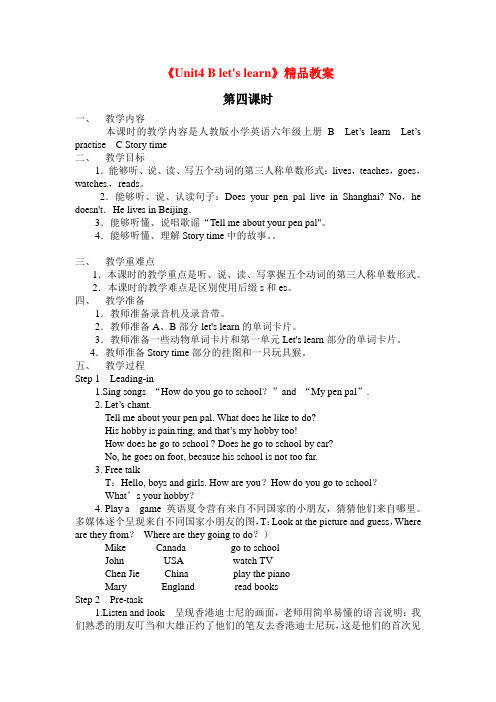
《Unit4 B let's learn》精品教案第四课时一、教学内容本课时的教学内容是人教版小学英语六年级上册 B Let’s learn Let’s practise C Story time二、教学目标1.能够听、说、读、写五个动词的第三人称单数形式:lives,teaches,goes,watches,reads。
2.能够听、说、认读句子:Does your pen pal live in Shanghai? No,he doesn't.He lives in Beijing.3.能够听懂、说唱歌谣“Tell me about your pen pal"。
4.能够听懂、理解Story time中的故事。
三、教学重难点1.本课时的教学重点是听、说、读、写掌握五个动词的第三人称单数形式。
2.本课时的教学难点是区别使用后缀s和es。
四、教学准备1.教师准备录音机及录音带。
2.教师准备A、B部分let's learn的单词卡片。
3.教师准备一些动物单词卡片和第一单元Let's learn部分的单词卡片。
4.教师准备Story time部分的挂图和一只玩具猴。
五、教学过程Step 1 Leading-in1.Sing songs “How do you go to school?”and “My pen pal”.2. Let’s chant.Tell me about your pen pal. What does he like to do?His hobby is pain ting, and that’s my hobby too!How does he go to school ? Does he go to school by car?No, he goes on foot, because his school is not too far.3. Free talkT:Hello, boys and girls. How are you?How do you go to school?What’s your hobby?4. Play a game 英语夏令营有来自不同国家的小朋友,猜猜他们来自哪里。
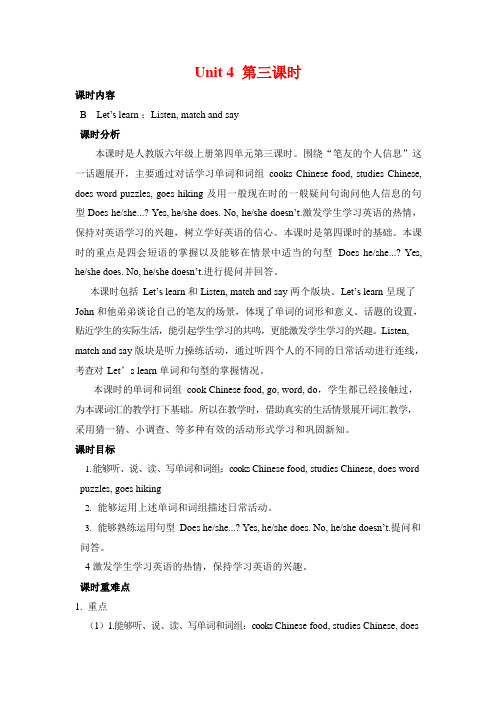
Unit 4 第三课时课时内容B Let’s learn ;Listen, match and say课时分析本课时是人教版六年级上册第四单元第三课时。
围绕“笔友的个人信息”这一话题展开,主要通过对话学习单词和词组cooks Chinese food, studies Chinese, does word puzzles, goes hiking 及用一般现在时的一般疑问句询问他人信息的句型Does he/she...? Yes, he/she does. No, he/she doesn’t.激发学生学习英语的热情,保持对英语学习的兴趣,树立学好英语的信心。
本课时是第四课时的基础。
本课时的重点是四会短语的掌握以及能够在情景中适当的句型Does he/she...? Yes, he/she does. No, he/she doesn’t.进行提问并回答。
本课时包括Let’s learn 和Listen, match and say 两个版块。
Let’s learn 呈现了John 和他弟弟谈论自己的笔友的场景,体现了单词的词形和意义。
话题的设置,贴近学生的实际生活,能引起学生学习的共鸣,更能激发学生学习的兴趣。
Listen, match and say 版块是听力操练活动,通过听四个人的不同的日常活动进行连线,考查对Let’s learn 单词和句型的掌握情况。
本课时的单词和词组cook Chinese food, go, word, do,学生都已经接触过,为本课词汇的教学打下基础。
所以在教学时,借助真实的生活情景展开词汇教学,采用猜一猜、小调查、等多种有效的活动形式学习和巩固新知。
课时目标1.能够听、说、读、写单词和词组:cooks Chinese food, studies Chinese, does word puzzles, goes hiking2.能够运用上述单词和词组描述日常活动。

PEP六年级上册Unit 4I Have a Pen Pal说课稿第二课时河西堡第一小学李秀英尊敬的各位老师:大家好!今天我说课的内容是新人教版小学英语六年级上册第四单元《I Have A Pen Pal》A部分中的Let’s Learn .这节课主要围绕五个动词短语展开的。
接下来,我将从教材分析、教法、学法、教学流程、板书设计、课后反思这几个方面和大家作个交流。
一、说教材首先来说说教材,这部分内容是六年级上册第四单元“I have a pen pal”的第一课时,包括A部分Let’s learn和Group work。
本课时主要是学习几个表达爱好的动词短语,同时掌握询问他人的爱好并作答。
本课在整套PEP版教材中起着承上启下的作用,孩子们已经掌握了一些动词的ing形式,而且已经学习了I like ......句型。
所以教学时就可以以旧引新。
另外如果本课学扎实了,再学习本单元的后几课时,就简单多了。
基于以上对教材的理解,我制订了以下教学目标:二、教学目标:1、知识目标:(1)能够听、说、认读句子:What are your hobbies ? I like dancing.(2)能够听、说、读、写动词短语的ing形式及其读音dancing,singing,reading stories,playing football,doing kung fu。
2、能力目标:(1)通过学习,能够询问和简单描述业余爱好。
(2)通过学习,使学生能够仿照课文中的句子询问别人的业余爱好后做出总结汇报。
(3)通过对本课单词、短语、句型的学习,培养学生获得如何询问和描述人们的兴趣爱好的表达能力。
3、情感目标:(1)通过学习What are your hobbies ?句型,鼓励学生发展广泛的兴趣与爱好,以及乐于与人交往的性格。
(2)通过学习,能积极运用所学语言进行表达与交流,加强合作,共同完成学习任务。
2、教学重难点考虑到学生的已有知识水平及本课的教学目标,我把掌握五个动词短语的ing形式定为本课的重点。
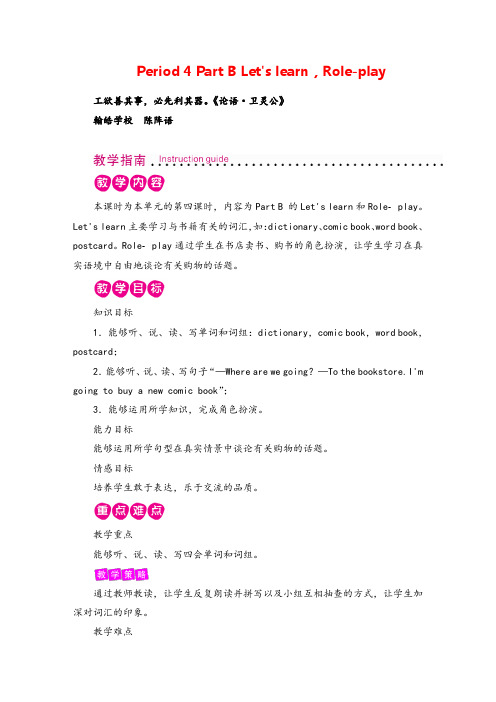
Period 4 Part B Let's learn,Roleplay 工欲善其事,必先利其器。
《论语·卫灵公》翰皓学校陈阵语本课时为本单元的第四课时,内容为Part B 的Let's learn和Roleplay。
Let's learn主要学习与书籍有关的词汇,如:dictionary、comic book、word book、postcard。
Roleplay通过学生在书店卖书、购书的角色扮演,让学生学习在真实语境中自由地谈论有关购物的话题。
知识目标1.能够听、说、读、写单词和词组:dictionary,comic book,word book,postcard;2.能够听、说、读、写句子“—Where are we going?—To the bookstore.I'm going to buy a new comic book”;3.能够运用所学知识,完成角色扮演。
能力目标能够运用所学句型在真实情景中谈论有关购物的话题。
情感目标培养学生敢于表达,乐于交流的品质。
教学重点能够听、说、读、写四会单词和词组。
通过教师教读,让学生反复朗读并拼写以及小组互相抽查的方式,让学生加深对词汇的印象。
教学难点1.掌握单词dictionary的发音;2.能够灵活运用所学语言在真实情景中谈论有关购物的话题。
教师采用拆分法教读,让学生模仿并反复朗读;教师创设不同情景,让学生通过小组合作进行角色扮演反复操练相关句型。
多媒体课件、词典、连环画册、单词书、明信片。
Step 1:Warmup1.师生说唱:Where are you going?Where are you going?We're going to the cinema.We're going to the cinema.When are you going?When are you going?Next Tuesday.Next Tuesday.Wy?Why?Why?Half price.Half price.Because it's half price.2.教师用多媒体展示被遮住一部分的地点图片,让学生猜一猜地点。
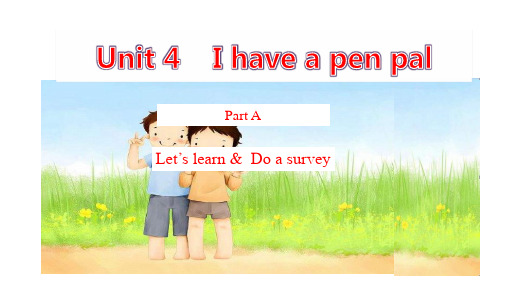
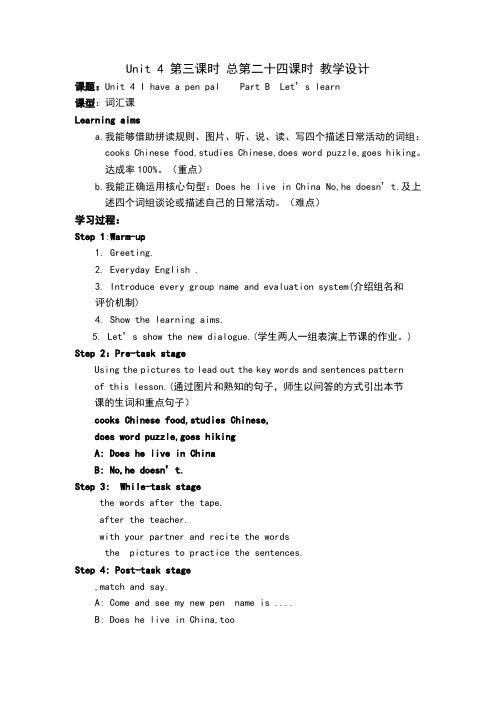
Unit 4 第三课时总第二十四课时教学设计课题:Unit 4 I have a pen pal Part B Let’s learn课型:词汇课Learning aimsa.我能够借助拼读规则、图片、听、说、读、写四个描述日常活动的词组:cooks Chinese food,studies Chinese,does word puzzle,goes hiking。
达成率100%。
(重点)b.我能正确运用核心句型:Does he live in China No,he doesn’t.及上述四个词组谈论或描述自己的日常活动。
(难点)学习过程:Step 1:Warm-up1. Greeting.2. Everyday English .3. Introduce every group name and evaluation system(介绍组名和评价机制)4. Show the learning aims.5. Let’s show the new dialogue.(学生两人一组表演上节课的作业。
) Step 2:Pre-task stageUsing the pictures to lead out the key words and sentences patternof this lesson.(通过图片和熟知的句子,师生以问答的方式引出本节课的生词和重点句子)cooks Chinese food,studies Chinese,does word puzzle,goes hikingA: Does he live in ChinaB: No,he doesn’t.Step 3: While-task stagethe words after the tape.after the teacher.with your partner and recite the wordsthe pictures to practice the sentences.Step 4:Post-task stage,match and say.A: Come and see my new pen name is ....B: Does he live in China,tooA: No,he doesn’ lives in ....B: Does he ....A: Yes,he does./ No, he doesn’t.①Talk about with your partners.② Show in class.the new dialogue on the exercise-book and show.Step 5:Sum upThis class I have learned . Step 6:Homeworka. If you can recite the words, please write once from memory.You can get 3 stars. If you can’t, please copy the words three times. You can get 2 stars.b. Talk about the traffic rules with your partner and write thedialogue on your exercise-book, you can get 5 stars.Writing design:Unit 4 I have a pen palPart B Let’s learncooks Chinese food,studies Chinese,does word puzzle,goes hikingA: Does he live in ChinaB: No,he doesn’t.Reflection after class:。
Unit4 B Let’s learn公开课教案一、教学目标1. 本部分学生学习的单词和词组是:cooks Chinese food, studies Chinese, does word, puzzles, goes hiking。
教材通过John和他弟弟谈论自己笔友的场景呈现了单词的词形和意义。
2. 本部分的教学目标是:学生能够听、说、读、写上述单词和词组;能够熟练运用句型Does he / she …? Yes, he / she does. No, he / she doesn’t.二、学情分析学生目前已有一定的英语语言基础,会基本的日常会话。
在前几个课时学习了一些表示爱好的单词和词组dancing, singing, reading stories, playing football, doing kung fu,句型What are he / she’s hobbies? He / She likes … 本单元的主题I have a pen pal,主要通过网络和朋友进行沟通交流,学生比较感兴趣,对外国小朋友的平时做些什么也很好奇。
所以本节课我设计让学生尝试交一个外国网友,在选择外国网友的过程中学习更多的词组和句型。
三、重点难点重点:掌握五个词组:cook Chinese food, studies Chinese, does word puzzles, goes hiking.难点:能正确区分并运用动词第三人称单数与第一人称进行相关的表达。
四、教学过程活动1【导入】Warm-up&Lead in一、Warm-up1. Greetings.T: Hello, boys and girls. How are you today?Ss: I’m fine, thank you. And you?T: Very well, thanks.2. Free talk.T: Great weather, isn’t it? I want to fly a kite this weekend. What do you often do on the weekends?Ss: I often …T: I often surf the Internet. I often chat with my QQ friends. Do you have QQ friends?How many QQ friends do you have? Where are they from? Do you have foreign friends?Ss: ...T: I have! Do you want to have one …? Today, I’ll help you! I’m going to introduce some of my foreign QQ friends to you. If you have the same hobbies with them, you can be QQ friends each other. I hope everyone can make a foreign friend today.设计意图:通过课余生活的讨论,引出本节课的主线—QQ聊天。